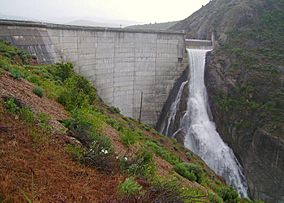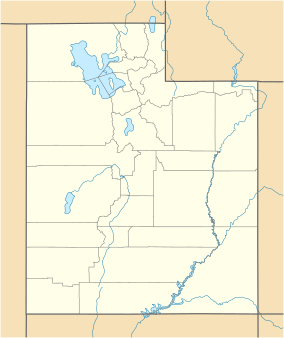East Canyon State Park facts for kids
Quick facts for kids East Canyon State Park |
|
|---|---|
|
IUCN Category V (Protected Landscape/Seascape)
|
|

East Canyon Dam
|
|
| Location | Morgan, Utah, United States |
| Area | 267 acres (108 ha) |
| Elevation | 5,700 ft (1,700 m) |
| Established | 1962 |
| Visitors | 100250 (in 2011) |
| Governing body | Utah State Parks |
East Canyon State Park is a fun state park in Utah, USA. It has a big lake, called a reservoir, that covers about 608 acres. This park is located in Morgan County, Utah, which is northeast of Salt Lake City. It's a great spot for outdoor adventures!
Contents
What Can You Do at East Canyon State Park?
East Canyon State Park is nestled in a narrow canyon. It sits high up, about 5,700 feet above sea level. The park is open all year, so you can visit any time.
Boating and Water Fun
The park has a concrete ramp for launching boats. There is also plenty of paved parking for your vehicles. You can even rent a boat if you don't have your own! The large reservoir is perfect for many water activities.
Camping and Amenities
If you love camping, East Canyon has a campground with 33 spots for RVs. Some spots have full hookups, meaning they have water, electricity, and sewer connections. Others have partial hookups. The park also provides clean restrooms and showers. There's even a special station to clean fish you catch!
Group Gatherings
For bigger groups, there are two covered pavilions. These are great for picnics, parties, or family reunions. You can also grab a quick bite at the snack bar.
East Canyon Dam: How the Lake Was Made
The lake at East Canyon State Park was created by the East Canyon Dam. This dam is a type called an arch concrete dam. It's shaped like a curve, which helps it hold back a lot of water.
Dam Size and Construction
The East Canyon Dam is about 259 feet tall and 436 feet long. Its base is 20 feet wide, and the top is 7 feet wide. The dam was built between 1964 and 1966.
Water Source
The reservoir gets its water from East Canyon Creek. This dam and reservoir are part of a bigger plan called the Weber Basin Project. This project helps manage water for the area.



